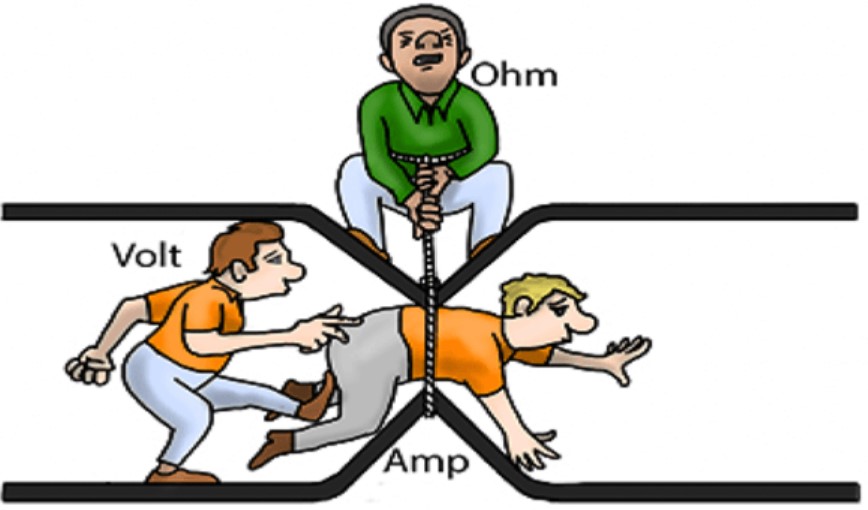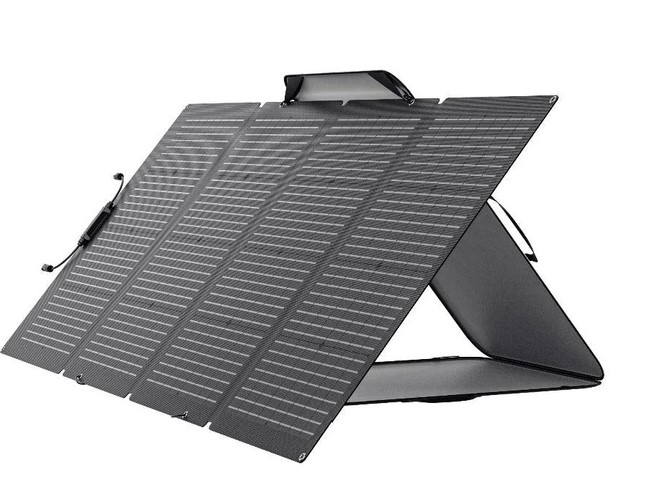Portable Power Stations – power on the go (Off-grid update 8/24)

Portable Power Stations are the next big thing, with brands like Anker Solix, Bluetti, EcoFlow, Jackery and many more vying for your custom. But we discovered that buying the right one for your needs is far more complex than imagined.
At their most basic, portable power stations are just big rechargeable DC battery banks. When charged, they convert (invert) the power to a mix of 240V AC and 5 to 20V DC.
Who is buying them?
Campers, caravan/motor homes, tradies (on-site), boat owners, medical equipment users (CPAP), unreliable mains power supply (blackouts), and anyone who wants portable power without using a fuel-powered generator. Unfortunately, they are a bit too small at present for EV owners’ emergency on-road top-ups—watch this space.
Here is what to look for in portable power stations. Note images used are from the companies above and do not imply endorsement until reviewed.
OHM’s LAW – you need to understand this – Volts x Amps = Watts
- Volts are the force required to make Amps (current) flow. Think of water pressure in a pipe.
- Amps are the current flow volume (Amps are the killer, and anything above 20mA can cause death).
- Watts is the total energy the device uses.

For example, a radiant bar heater uses 240V AC x 10A = 2400W (the maximum a household circuit breaker can handle), while a laptop may use 20V DC x 3A = 60W.
If you are interested in how Amps kill, read this.

Next is AC and DC power. Batteries can only store DC power (Direct Current) and use an inverter to make AC (alternating current).
Theoretical Battery Capacity (Wh)
Think of this as litres of fuel in the tank. Fuel economy (real kilometres per litre) depends on the car’s load, speed, and braking. The bigger the capacity, the more devices it can run for longer.
- Wh = 1W for an hour. kWh = 1000W for an hour
You may have to look to find these figures because most portable power stations advertise Inverter capacity. The higher the Wh, the longer it can support a load.

Let’s explain real usable battery capacity (also known as operation time)
Assume we have a single 100W incandescent bulb and we have a Bluetti AC200L 2400W/2048Wh – portable power station with 2048Wh. We are using Bluetti as an example as it freely divulges this information – other brands often do not. The other factors you must know are:
- Depth of Discharge (DOD): Most manufacturers cut off the power at 80% discharge. This is totally unnecessary for Lithium Iron Phosphate (LiFePO4) batteries that can stand a 100% discharge. Bluetti uses 95% to be safe.
- Inverter Efficiency: Most brands will not disclose this, but tests show that 85-87% to invert (convert) DC to AC is fair. Bluetti claims 93% efficiency, and our tests have verified that.
- Unit consumption under load: Most will go into standby without load, but some can discharge at about 5% per day, even when off. Bluetti claims the unit consumption is 12W per hour when active and <1W when idle.
So the real battery capacity is 2048Wh x DOD (95%) x inverter efficiency (93%)/ Light bulb wattage (100) + unit consumption (12W) = hours of use (16.155 hours) or about 80%.
We have used the same test on other brands, and most averaged about 13 hours, so the Bluetti is about 24% more efficient.
Inverter capacity (total Wattage Output)
Think of this as how much horsepower you need – if you tow a caravan, you need more power.
The inverter takes the battery’s stored DC power and turns it into AC power. For example, it may have a 1000W inverter. That means the total wattage you can support is 1000W, but inverter technology varies and may not sustain 1000W (what we call Peak Wattage); conversely, it may be able to peak for a few seconds at nearly twice that.
There are at least two types of inverters. The cheap ones are square wave (sometimes called Modified Sine Wave). Fridges, jugs, power tools etc., can use square wave. But the better and more costly ones are pure sine wave (smooth). Any electronic (IT) equipment needs a sine wave, so make sure you buy this.
We also need to factor into account inverter efficiency. The majority will be at most 85% efficient at converting DC into AC, so assume that the quoted Wh is about 15% higher than reality.
Inverter Sustained/peak output – Peak Wattage
Think of this as the top speed the car can reliably reach and stay at. It may be capable of 200kph for short bursts but can only reliably do 100kph all day.
When you turn on a fridge, it may jump to 2400W (maximum) as the compressor starts. After that, it may settle back to 500-700W.
In this case, you need an inverter to handle a 2400W peak load. Or if you have several devices attached, it must take their peak loads simultaneously.
Types of output AC and DC
Think of this as seats in a car—bucket, bench, baby seat, etc. There is no use in buying a two-seat sports car if you need five seats, etc. Some portable power stations have many AC and/or DC ports, but regardless of port numbers, you must ensure the peak and sustained loads are not exceeded.
For example, the NRGVault pictured below has four x 1500W ports but only a 1500W inverter; the maximum load across all four ports is 1500W. Don’t think you can plug in a power board for more outlets!
DC is much more forgiving as USB-A and USB-C ports have power standards. USB-A are generally 5V/1 or 2A/5 or 10W but some may also have 5V/3A/15V and 9V/2A/18W (called QC 2.0 or 3.0).
USB-C usually has a PD (Power Delivery) of 5V/3A/15W, but some may have PD as high as 20V/5A/100W.
If you use it for USB electronic devices like notebooks or smartphones, look for PD/PPS/QC compatible ports that can charge at least 20V/3A/60W (typical laptop).

Battery Technology, charge cycles and lifespan
Portable power stations use Lithium-Ion (Li-Ion), Lithium-polymer (Li-Po), Lithium Iron Phosphate (LiFePO4 or LFP), lead-acid (like a car battery), Nickle cadmium (NiCad), and even rechargeable Alkaline batteries. Inside will be dozens to hundreds of individual batteries.
- Lithium-ion batteries are the most energy-dense and charge three times faster than lead-acid batteries. The downside is that they should never be discharged completely (80% useable), have an increased fire and toxic smoke risk, and lose charge faster when unused. Lithium-ion batteries can have 300-500 charge cycles. DO NOT BUY CHEAPER LITHIUM-ION POWER STATIONS—THEY ARE A BOMB WAITING TO HAPPEN.
- Lithium-polymer (Li-Po) batteries are less energy-dense than Li-Ion batteries but have faster charging capabilities, better charge retention, and are generally safer (less fire risk). Li-Po typically has 2000+ charge cycles.
- Lithium Iron Phosphate (LiFePO4 or LFP) has a lower energy density (requires more battery cells) but has higher safety and low toxicity, and the better ones have 3000+ charge cycles. THIS IS THE ONLY SAFER POWER STATION TO BUY.
- Lead-acid batteries (car batteries) are the most affordable but are bulky, comparatively slow-charging, and have the least energy density. They also self-discharge faster if not used and charged. These are more for permanent installations like power failover backup.
- Avoid Ni-Cad and rechargeable Alkaline – these would only be found in smaller portable power stations.
Charge cycles are the number of times you can recharge from 0 to 100%, and one cycle equals two half cycles, etc. The lower-cost units may have as few as 300 charge cycles, whereas the better ones may have 3000+. Once reached, the batteries may only hold 80% of a full charge (normal).

Standby time
Portable power stations lose energy when not in use. To preserve battery charge cycles, you must top them up every few months. So, if you only plan on using it occasionally, set a reminder in your calendar.
Weight and size
Remember, the more Wh, the more batteries and more weight. The operative word is portable, so figure on smaller ones at <10kg and larger ones from 15-30kg.


Charging sources
All will have a 240V charge port (240V electricity is a maximum of 2400W). Most will charge at 240V/5A/1000W so as not to overload a power circuit. Charge times depend on the capacity, and as a rule of thumb, if you have a 1500Wh unit, it will take at least 1.5 hours (1500/1000=1.5 hours). Of course, some recharging energy is lost to heat, so it is safe to assume it may take a little longer.
Some have a vehicle charging port. Most cars have a 12V socket (varies between 13.5-15V when running) and can output 10A (some are rated to 20A – check the fuse rating), giving 120-135W. Using the formula 1500Wh/135W=11.11 hours at least of charge time. If you plan to use the car regularly to charge it, an auto electrician can tell you the maximum Volt/Amp port they can install. Tradies often have a 12-30V/7A/200W port fitted, bringing charging time back to 7.5 hours.

Solar is another source. Depending on the panel types (usually folding to fit in a car or van) and with the wattage they can produce during sunlight hours, you may be able to charge at up to 1200W. That means a 1500W battery could be charged in 5 hours, although solar has a lower energy density and greater conversion loss (most panels are 20% efficient)

IP rating
Electricity and water do not mix. If you intend to use this outdoors, it must have an IP rating of at least IP67 and some outlet protection to prevent water from getting onto the plugs.
Fire-risk
All Lithium-based batteries present a fire risk, especially if mishandled. While minimal, as a precaution, you should only charge them in an open space (like a garage).
It should have an electronic battery management system that covers protection against Under/Over Voltage, Over Current, Short Circuit, Overcharging Voltage, Over Temperature, and Overload.
Some also have a Residual Current Circuit Breaker (RCCB) and or Ground Fault Circuit Interrupter (GFCI) that senses current and disengages any voltage circuit whenever a fault occurs.
If not, invest in an HPM Electresafe Power Centre with two USB outlets REPC410USB (review).
LCD readouts
Most have an LCD readout, like the Bluetti featured below. As long as the unit shows the remaining Wh, port loads, and charge status, you will cover most things.

Nice, but not necessary
Some have Qi Charge pads, NFC, torch, BT/Wi-Fi smartphone Apps and more.
If the device is heavy, look for integrated handles and wheels (like a suitcase).
Most offer a UPS (uninterruptible power supply) mode that can take over when the mains power goes down. These need to be hooked into a special circuit and only support the recommended peak load of devices on that circuit. Look for switch-over rates well below 20ms.
Some brands offer various accessories like solar panels, charge cables and in-home ecosystem connection options.

Expandability
Some offer battery expansion packs. If you think you will need power (Wh) for longer, these are a good idea but remember that the inverter has a fixed Amperage.

Warranty, backup, and service
We strongly suggest you avoid buying any unit with less than five years’ warranty. Also, avoid so-called extended warranties offered by retailers—ACL covers this anyway.
Look for well-known brands with Australian offices, warehousing, and service facilities. Remember that these are heavy units, and you may be up for a lot of money to freight them back if needed for warranty. Look for those that cover freight both ways if the unit is faulty. Most will replace a faulty unit with a refurbished one with the balance of your new warranty.
It is safest to buy from a recognised retailer like Harvey Norman or recognised camping and recreational outlets with good customer service and return policies. All will be made in China—there are no alternatives.
Brands to look for include Bluetti, EcoFlow, Anker Solix, Jackery and NRGVault.
Sustainability
What do you do at the end of your life? Is the whole unit recyclable or disposable? Most portable power stations will use 32700 size, 3.2V, 6000mAh batteries (or similar). A 500W unit uses about 16-20, and a 1500W about 65-70. The individual batteries are available for under $10 each. Currently, no maker has a battery replacement policy, but several battery repacking companies claim to be able to replace cells (you must replace all cells).
How to ‘roughly’ compare prices
As a guide, the cost per watt/hour Wh at 240V (not DC Wh) is a good start. Leaving aside brands and technologies, the usual price per Wh varies from $2-4 (larger banks have lower per Wh). Don’t calculate using Ah or confuse this with the advertised inverter Wattage capacity.
Then, you can look at power cycles. If a unit has 3000 power cycles and costs $1000, that is 33 cents (plus electricity) per charge. If the same unit has 500 power cycles, that is $2 per charge.
We have completed a guide (at August 2024) that compares the major brands and works out the costs for you. Best portable power stations – time for glamping and more (off-grid 10/24)
Summary – portable power stations
- Know what load/time in Wh you need to support. There is no point in buying less capacity than you need.
- Know what peak load you need to support (inverter capacity). There is no point in purchasing a device that won’t let you attach a fridge or power tool in startup mode.
- LiFePO4 is preferable to Li-Po, which is preferable to Li-Ion.
- Multiple charging inputs are useful but not the main reason to buy.
- Sine Wave inverter
- If you intend to use sensitive USB electronic devices, ensure the portable power station supports PD or PPS charging.
- Watch the weight and size and make sure you can lift it easily (or buy two smaller ones).
Portable power stations are only a short-term substitute for a generator (which runs on petrol, diesel, or gas), although it is relatively silent (it may have a fan for cooling). This means it is safe to use indoors out of the weather.
Brought to you by CyberShack.com.au







